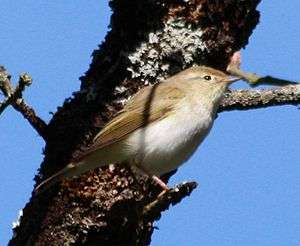Western Bonelli's warbler
| Western Bonelli's warbler | |
|---|---|
 | |
| Scientific classification | |
| Kingdom: | Animalia |
| Phylum: | Chordata |
| Class: | Aves |
| Order: | Passeriformes |
| Family: | Phylloscopidae |
| Genus: | Phylloscopus |
| Species: | P. bonelli |
| Binomial name | |
| Phylloscopus bonelli (Vieillot, 1819) | |
Western Bonelli's warbler is a "warbler" in the leaf warbler genus Phylloscopus. It was formerly regarded as the western subspecies of a wider "Bonelli's warbler" species, but as a result of modern taxonomic developments, this species is now usually considered to be two species:[2][3]
- Western Bonelli's warbler, Phylloscopus bonelli, which breeds in south west Europe and north Africa
- Eastern Bonelli's warbler, Phylloscopus orientalis, which breeds in south east Europe and Asia Minor
The breeding ranges of the two species do not overlap; while their appearance and songs are very similar, the calls are completely different (see below). They also show marked difference in mtDNA sequence.[4]
The species is migratory, wintering in sub-Saharan Africa. It is a rare vagrant in Northern Europe.
The genus name Phylloscopus is from Ancient Greek phullon, "leaf", and skopos, "seeker" (from skopeo, "to watch").[5] The English name and the specific bonelli are for the Italian ornithologist Franco Andrea Bonelli.[6]
Description
.jpg)
Western Bonelli's warbler is a small passerine bird, found in forest and woodland. 4–6 eggs are laid in a nest on the ground. Like most warblers, western Bonelli's is insectivorous.
The adult has a plain grey-green back, green-toned rump and wings and whitish underparts. The bill is small and pointed and the legs brown. The sexes are identical, as with most warblers.
The western Bonelli's warbler has a browner tinge to the upperparts than eastern Bonelli's warbler; the latter sometimes has a greenish tinge instead. The song is a fast monotone trill, only slightly different from eastern Bonelli's, and also some similarity to wood warbler. The call of the western Bonelli's warbler is a disyllabic hu-it, differing from that of eastern which is a completely different hard chup, reminiscent of a crossbill or a house sparrow.[7]
References
- ↑ BirdLife International (2012). "Phylloscopus bonelli". IUCN Red List of Threatened Species. Version 2013.2. International Union for Conservation of Nature. Retrieved 26 November 2013.
- ↑ Parkin, David T. (2003): Birding and DNA: species for the new millennium. Bird Study 50(3): 223–242. HTML abstract
- ↑ Sangster, George; Knox, Alan G.; Helbig, Andreas J. & Parkin, David T. (2002): "Taxonomic recommendations for European birds." Ibis 144(1): 153–159.
- ↑ Helbig, A. J.; Seibold, I.; Martens, J. & Wink, M. (1995): Genetic differentiation and phylogenetic relationships of Bonelli's Warbler Phylloscopus bonelli and Green Warbler P. nitidus. J. Avian Biol. 26: 139–153.
- ↑ Jobling, James A (2010). The Helm Dictionary of Scientific Bird Names. London: Christopher Helm. p. 305. ISBN 978-1-4081-2501-4.
- ↑ Beolens, Bo; Watkins, Michael (2003). Whose Bird? Men and Women Commemorated in the Common Names of Birds. London: Christopher Helm. p. 59.
- ↑ Helb, H.-W.; Bergmann, H.-H. & Martens, J. (1982): Acoustic differences between populations of western and eastern Bonelli's Warblers (Phylloscopus bonelli, Sylviidae). Cellular and Molecular Life Sciences 38(3): 356–357.
